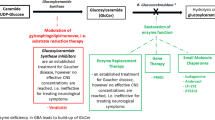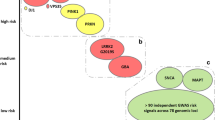Abstract
Parkinson’s disease (PD) is a progressive neurodegenerative disorder characterized by a heterogeneous array of motor and non-motor features. Anti-PD drugs that are in use target only the motor symptoms, may lose efficacy over time, and can cause serious adverse effects such as dyskinesia and psychosis. There are currently no preventative or disease modifying treatments. All attempts to develop disease modifying drugs have failed. Pharmacogenomics (PGx) has the potential to change the way new drugs are developed and the way drugs are prescribed. By using genetic markers that correlate with, and can therefore predict drug response, clinical trials can be designed to be enriched with individuals who are most likely to benefit from the drug, maximizing drug’s efficacy, minimizing its adverse effects, and boosting the odds of successful drug discovery. Clinical application of PGx will help physicians to quickly and accurately determine the right drugs and the right doses for individuals, avoiding the lengthy trial and error approaches and adverse effects. In combination with known protective factors such as nicotine and caffeine, PGx may enable development of personalized methods for PD prevention and, by extension, care.
Similar content being viewed by others
References
Factor SA. Current status of symptomatic medical therapy in Parkinson’s disease. Neurotherapeutics 2008;5(2):164–80.
Sweet RD, McDowell FH. Five years’ treatment of Parkinson’s disease with levodopa. Therapeutic results and survival of 100 patients. Ann Intern Med 1975;83:456–63.
Fahn S, Oakes D, Shoulson I, et al. Levodopa and the progression of Parkinson’s disease. NEJM. 2004;351(24):2498–508. doi:10.1056/NEJMoa033447.
Ahlskog JE, Muenter MD. Frequency of levodopa-related dyskinesias and motor fluctuations as estimated from the cumulative literature. Mov Disord 2001;16(3):448–58.
Olanow CW. Tolcapone and hepatotoxic effects. Tasmar Advisory Panel. Arch Neurol 2000;57:263–7.
Hart RG, Pearce LA, Ravina BM, Yaltho TC, Marler JR. Neuroprotection trials in Parkinson’s disease: systematic review. Mov Disord 2009;24:647–54. doi:10.1002/mds.22432.
Burt T, Dhillon S. Pharmacogenomics in early-phase clinical development. Pharmacogenomics 2013;14:1085–97. doi:10.2217/pgs.13.81.
Maliepaard M, Nofziger C, Papaluca M, et al. Pharmacogenetics in the evaluation of new drugs: a multiregional regulatory perspective. Nat Rev Drug Discov 2013;12(2):103–15.
Collins FS. Reengineering translational science: the time is right. Sci Transl Med. 2011;3:90
Chan A, Pirmohamed M, Comabella M. Pharmacogenomics in neurology: Current state and future steps. Ann Neurol 2011;70:684–97.
Li J, Zhang L, Zhou H, Stoneking M, Tang K. Global patterns of genetic diversity and signals of natural selection for human ADME genes. Hum Mol Genet. 2011;20(3):528–40.
Schroder A, Klein K, Winter S, et al. Genomics of ADME gene expression: mapping expression quantitative trait loci relevant for absorption, distribution, metabolism and excretion of drugs in human liver. Pharmacogenomics J. 2013;13(1):12–20.
Ingelman-Sundberg M. Pharmacogenetics of cytochrome P450 and its applications in drug therapy: the past, present and future. Trends in Pharmacological Sciences 2004;25:193–200.
McLeod HL. Cancer pharmacogenomics: early promise, but concerted effort needed. Science 2013;339:1563–6.
Yang J, Chen Y, Li X, et al. Influence of CYP2C9 and VKORC1 genotypes on the risk of hemorrhagic complications in warfarin-treated patients: A systematic review and meta-analysis. Int J Cardiol. 2013;168(4):4234–4. doi:10.1016/j.ijcard.2013.07.151.
Guay DR. Tetrabenazine, a monoamine-depleting drug used in the treatment of hyperkinetic movement disorders. Am J Geriatr Pharmacother 2010;8:331–73.
Mehanna R, Hunter C, Davidson A, Jimenez-Shahed J, Jankovic J. Analysis of CYP2D6 genotype and response to tetrabenazine. Mov Disord 2013;28:210–5.
Pavlos R, Mallal S, Phillips E. HLA and pharmacogenetics of drug hypersensitivity. Pharmacogenomics. 2012;13:1285–306.
Mallal S, Phillips E, Carosi G, et al. HLA-B*5701 screening for hypersensitivity to abacavir. NEJM. 2008;358:568–79.
Arbouw ME, Guchelaar HJ, Egberts TC. Novel insights in pharmacogenetics of drug response in Parkinson’s disease. Pharmacogenomics 2010;11:127–9.
Kalinderi K, Fidani L, Katsarou Z, Bostantjopoulou S. Pharmacological treatment and the prospect of pharmacogenetics in Parkinson’s disease. Int J Clin Pract. 2011;65:1289–94.
Meiser J, Weindl D, Hiller K. Complexity of dopamine metabolism. Cell Commun Signal 2013;11:34.
Hardy J. Genetic analysis of pathways to Parkinson disease. Neuron 2010;68:201–6.
Trinh J, Farrer M. Advances in the genetics of Parkinson disease. Nat Rev Neurol. 2013;9(8):445–54.
Satake W, Nakabayashi Y, Mizuta I, et al. Genome-wide association study identifies common variants at four loci as genetic risk factors for Parkinson’s disease. Nat Genet. 2009;41:1303–7.
Hamza TH, Zabetian CP, Tenesa A, et al. Common genetic variation in the HLA region is associated with late-onset sporadic Parkinson’s disease. Nat Genet 2010;42:781–5.
Simon-Sanchez J, van Hilten JJ, van de Warrenburg B, et al. Genome-wide association study confirms extant PD risk loci among the Dutch. Eur J Hum Genet. 2011;19:655–61.
Do CB, Tung JY, Dorfman E, et al. Web-based genome-wide association study identifies two novel loci and a substantial genetic component for Parkinson’s disease. PLoS Genet 2011;7:e1002141.
Lill CM, Roehr JT, McQueen MB, et al. Comprehensive research synopsis and systematic meta-analyses in Parkinson’s disease genetics: the PDGene database. PLoS Genet. 2012;8(3):e1002548.
Pankratz N, Beecham GW, DeStefano AL, et al. Meta-analysis of Parkinson’s disease: identification of a novel locus, RIT2. Ann Neurol. 2012;71:370–84.
Harper AR, Topol EJ. Pharmacogenomics in clinical practice and drug development. Nat Biotechnol. 2012;30:1117–24.
Tanaka Y, Nishida N, Sugiyama M, et al. Genome-wide association of IL28B with response to pegylated interferon-[alpha] and ribavirin therapy for chronic hepatitis C. Nat Genet 2009;41:1105–9.
Ge D, Fellay J, Thompson AJ, et al. Genetic variation in IL28B predicts hepatitis C treatment-induced viral clearance. Nature. 2009;461(7262):399–401.
Suppiah V, Moldovan M, Ahlenstiel G, et al. IL28B is associated with response to chronic hepatitis C interferon-alpha and ribavirin therapy. Nat Genet 2009;41(10):1100–4.
Trevino LR, Shimasaki N, Yang W, et al. Germline genetic variation in an organic anion transporter polypeptide associated with methotrexate pharmacokinetics and clinical effects. J Clin Oncol 2009;27:5972–8.
Group SC, Link E, Parish S, Armitage J, et al. SLCO1B1 variants and statin-induced myopathy—a genomewide study. NEJM 2008;359(8):789–99.
Daly AK, Donaldson PT, Bhatnagar P, Shen Y, Péer I, Floratos A et al. HLA-B*5701 genotype is a major determinant of drug-induced liver injury due to flucloxacillin. Nat Genet. 2009;41:816–9.
Singer JB, Lewitzky S, Leroy E, et al. A genome-wide study identifies HLA alleles associated with lumiracoxib-related liver injury. Nat Genet. 2010;42:711–4.
Kindmark A, Jawaid A, Harbron CG, et al. Genome-wide pharmacogenetic investigation of a hepatic adverse event without clinical signs of immunopathology suggests an underlying immune pathogenesis. Pharmacogenomics J. 2008;8:186–95.
Hamza TH, Chen H, Hill-Burns EM, et al. Genome-wide gene-environment study identifies glutamate receptor gene GRIN2A as a Parkinson’s disease modifier gene via interaction with coffee. PLoS Genet. 2011;7(8):e1002237.
Hill-Burns EM, Singh N, Ganguly P, et al. A genetic basis for the variable effect of smoking/nicotine on Parkinson’s disease. Pharmacogenomics J 2012; doi:10.1038/tpj.2012.38
Quik M, Parameswaran N, McCallum SE, Bordia T, Bao S, McCormack A et al. Chronic oral nicotine treatment protects against striatal degeneration in MPTP-treated primates. J Neurochem. 2006;98:1866–75.
Chen JF, Xu K, Petzer JP, Staal R, Xu YH, Beilstein M et al. Neuroprotection by caffeine and A(2A) adenosine receptor inactivation in a model of Parkinson’s disease. J Neurosci. 2001;21:RC143.
Hernan MA, Takkouche B, Caamano-Isorna F, Gestal-Otero JJ. A meta-analysis of coffee drinking, cigarette smoking, and the risk of Parkinson’s disease. Ann Neurol 2002;52:276–84.
Powers K, Kay D, Factor S, et al. Combined effects of smoking, coffee and NSAIDs on Parkinson’s disease risk. Mov Disord 2008;23:88–95.
Dorus S, Vallender EJ, Evans PD, et al. Accelerated evolution of nervous system genes in the origin of Homo sapiens. Cell 2004;119:1027–40.
Caudle WM, Zhang J. Glutamate, excitotoxicity, and programmed cell death in Parkinson disease. Exp Neurol 2009;220:230–3.
Higley MJ, Sabatini BL. Competitive regulation of synaptic Ca2+ influx by D2 dopamine and A2A adenosine receptors. Nat Neurosci 2010;13:958–66.
Turner TJ. Nicotine enhancement of dopamine release by a calcium-dependent increase in the size of the readily releasable pool of synaptic vesicles. J Neurosci 2004;24:11328–36.
Sawcer S, Hellenthal G, Pirinen M, et al. Genetic risk and a primary role for cell-mediated immune mechanisms in multiple sclerosis. Nature 2011;476:214–9.
Postuma RB, Lang AE, Munhoz RP, Charland K, Pelletier A, Moscovich M et al. Caffeine for treatment of Parkinson disease: a randomized controlled trial. Neurology 2012;79:651–8.
Smith Y, Wichmann T, Factor SA, DeLong MR. Parkinson’s disease therapeutics: new developments and challenges since the introduction of levodopa. Neuropsychopharmacol 2012;37:213–46.
Kanda T, Jackson MJ, Smith LA, et al. Adenosine A2A antagonist: a novel antiparkinsonian agent that does not provoke dyskinesia in parkinsonian monkeys. Ann Neurol 1998;43:507–13.
Bibbiani F, Oh JD, Petzer JP, et al. A2A antagonist prevents dopamine agonist-induced motor complications in animal models of Parkinson’s disease. Exp Neurol 2003;184:285–94.
Hodgson RA, Bedard PJ, Varty GB, et al. Preladenant, a selective A(2A) receptor antagonist, is active in primate models of movement disorders. Exp Neurol 2010;225:384–90.
Dungo R, Deeks ED. Istradefylline: first global approval. Drugs. 2012;73:875–82.
Hauser RA, Cantillon M, Pourcher E, Micheli F, Mok V, Onofrj M et al. Preladenant in patients with Parkinson’s disease and motor fluctuations: a phase 2, double-blind, randomised trial. Lancet Neurol. 2011;10:221–9.
Author information
Authors and Affiliations
Corresponding author
Electronic supplementary material
Below is the link to the electronic supplementary material.
ESM 1
(PDF 1224 kb)
Rights and permissions
About this article
Cite this article
Payami, H., Factor, S.A. Promise of Pharmacogenomics for Drug Discovery, Treatment and Prevention of Parkinson’s Disease. A Perspective. Neurotherapeutics 11, 111–116 (2014). https://doi.org/10.1007/s13311-013-0237-y
Published:
Issue Date:
DOI: https://doi.org/10.1007/s13311-013-0237-y




